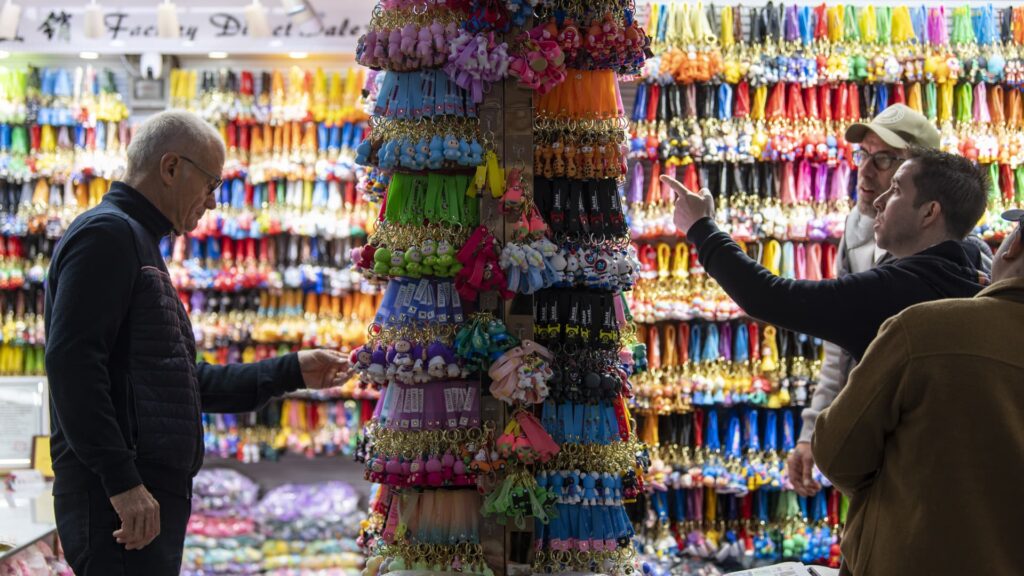YIWU, CHINA – NOVEMBER 26: November 26, 2024, saw foreign customers picking out holiday items at the China Yiwu International Trade City in Yiwu, Zhejiang Province.
Hu Xiao/VCG via Getty Images
In recent years, Christmas items have begun appearing on U.S. store shelves earlier due to retailers wanting to take advantage of the profitable holiday period—a trend known as “Christmas creep.”
However, tariffs may become a significant hurdle this year. Chinese manufacturers and their American clients face tariff-related challenges to ensure that stores in the U.S. are adequately stocked for Christmas.
Following U.S. President Donald Trump’s announcement of hefty tariffs on April 2—initially a 34% tariff on imports from China, which escalated to 145%—many U.S. retailers paused their orders from Chinese suppliers. This led to a slowdown in factory production, according to interviews conducted by CNBC.
Nonetheless, industry leaders report that some production has recently resumed as the risks of business disruptions start to outweigh tariff-related uncertainties.
“If production doesn’t begin in the next couple of weeks, retailers will miss out on Black Friday and Christmas sales,” said Cameron Johnson, a senior partner at consulting firm Tidalwave Solutions based in Shanghai, during a phone conversation on Tuesday.
“Both parties are making some flexible adjustments,” he noted. “Retailers are beginning to understand that halted supply chains will make it considerably harder to restart them later.”

Johnson illustrated how a halt in spoon orders would disrupt production in related industries, such as steel rolling and iron ore smelting. “These supply chains are interconnected, and when they begin to shut down, it could take time to reactivate them, even if a deal is reached.”
Although some goods from China are being redirected through other countries, altering established supply chains and shipping timelines is not a quick process. According to a Goldman Sachs assessment, over 70% of U.S. imports from China can only be sourced directly from China for about 36% of imports.
For instance, electronic items must depart from China by early September to arrive in the U.S. shortly after Thanksgiving. This timeline accounts for customs and distribution, as explained by Renaud Anjoran, the CEO of Agilian Technology, which supplies half of its goods to the U.S. market.
Manufacturing, testing, assembling, and packaging products require about six months, meaning suppliers should have ideally started gear for these orders in March, Anjoran said.
Declining shipments
Many U.S. buyers began stockpiling goods late last year, anticipating increased tariffs following Trump’s reelection. As stockpiling progressed, Chinese exports to the U.S. surged by 9.1% in March compared to the previous year, based on CNBC’s evaluation of customs data. In contrast, imports fell by 9.5% year-over-year. April’s trade statistics are expected on May 9.
However, stockpiling efforts have recently slowed. Shipping volumes of container ships leaving China for the U.S. have significantly dropped, according to shipping indicators tracked by Morgan Stanley. The number of canceled shipments skyrocketed by 14 times from April 14 to May 5 compared to the period between March 10 and April 7.
A gauge reflecting new export orders from Chinese factories hit its lowest point since late 2022, according to national statistics.
“At the moment, we don’t have many purchase orders for the upcoming months from U.S. clients,” Anjoran stated. Most of his clients stocked up inventory before the Chinese New Year at the end of January, with only minor orders coming in March and April.
Some U.S. buyers are postponing orders to see if tariffs will be reduced to more manageable levels in May before they restart shipments. Ryan Zhao, a director at Jiangsu Green Willow Textile, informed CNBC that their production is currently on hold due to U.S. client orders.
Recent developments suggest a push for some tariff reductions as both nations sought to mitigate the economic fallout from punitive tariffs. Reports indicate that China has granted tariff exemptions for specific U.S. products, such as pharmaceuticals, aerospace components, semiconductors, and ethane.
Additionally, Trump signed an executive order removing extra tariffs on foreign car imports and parts after previously rolling back tariffs on numerous electronic items, including smartphones, computers, and circuits.
Timing is key
Despite concerns about profit margins, some businesses are cautiously placing partial orders from China to avoid empty shelves, according to Tidalwave Solutions’ Johnson.
“Several factories informed me that some U.S. importers have directed them to restart production in an effort to time anticipated tariff adjustments,” Martin Crowley, vice president of product development at Seattle-based wholesale toy company Toysmith, wrote in an email Tuesday. The company is advising customers to place orders by May 16 for shipping by July 31 to secure current pricing unaffected by tariffs.
In recent days, various factories located in Yiwu, Shantou, and Dongguan have acquired clearance from Walmart and Target to resume production, Crowley noted. Walmart and Target did not provide an immediate comment to CNBC.
Some of Agilian’s customers are also opting to place smaller orders, hoping that tariff rates will reduce by the time their goods reach U.S. ports.
However, if a breakthrough occurs in U.S.-China trade talks and a rush to fulfill orders happens, it could lead to increased production expenses and shipping rates.
“It’s feasible to expedite production if the order quantities are small, but if numerous American customers rush at once, factories will be overwhelmed, and air shipping costs will spike,” Anjoran added.



